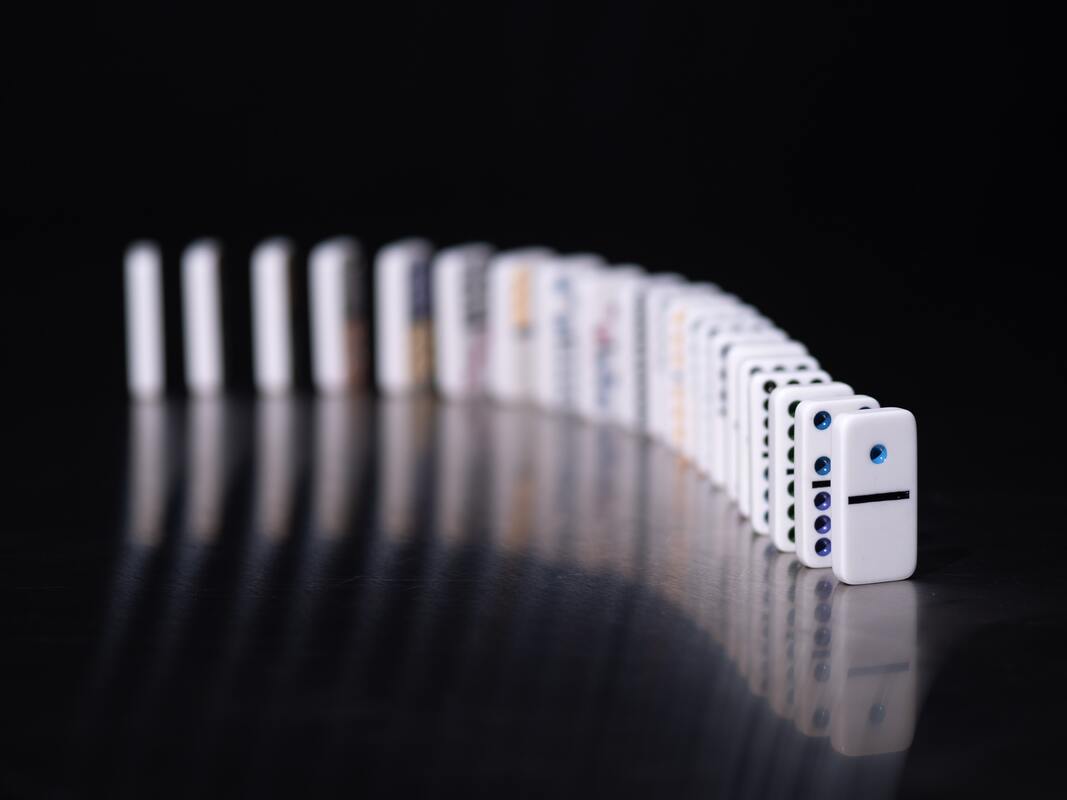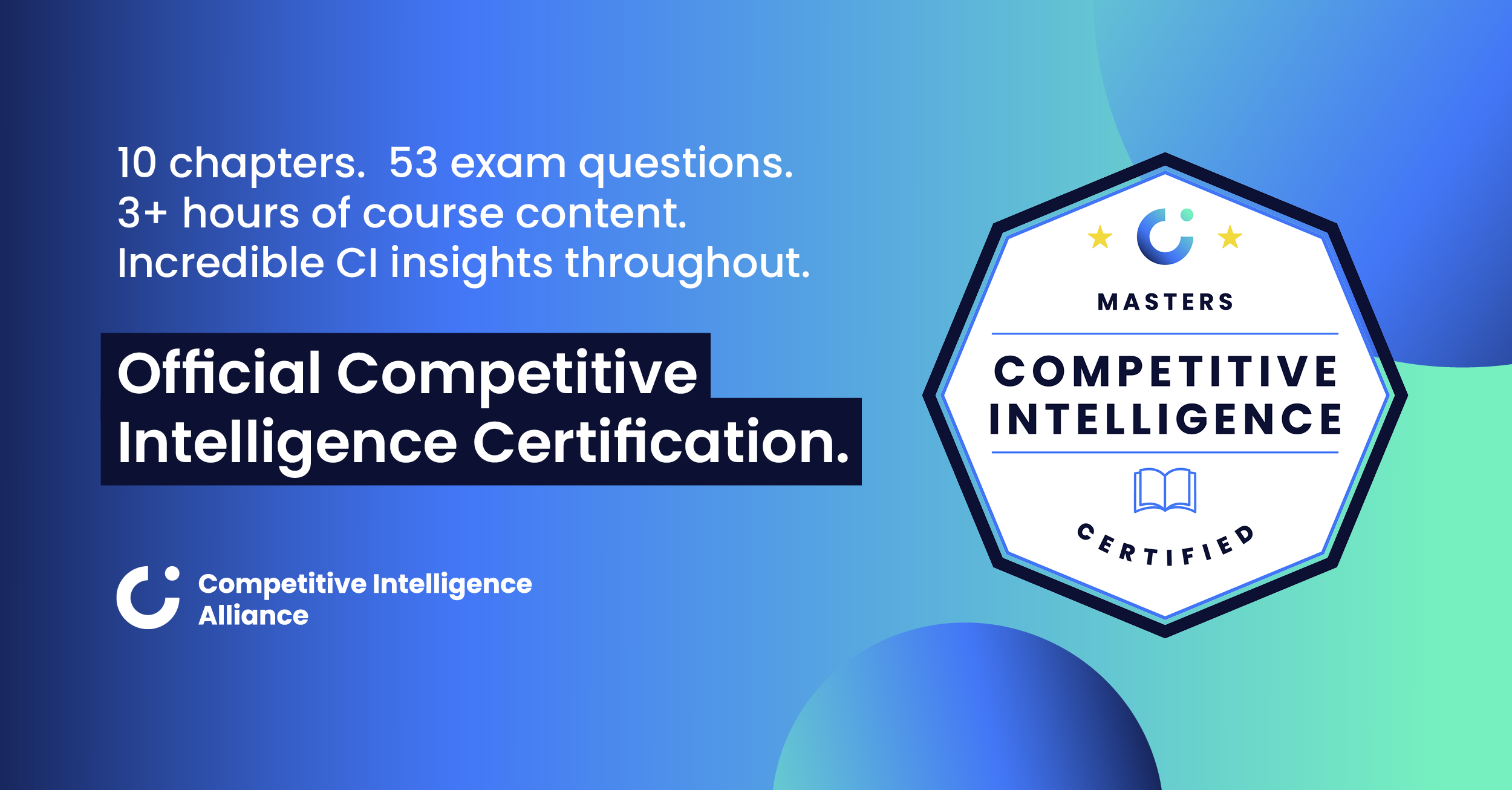This article was adapted from select material from our CI: Masters certification program, presented by Alex McDonnell.
If you’re in an organization with customer-facing teams, then sales and customer success (CS) are two of the most important groups you’ll spend time with.
What’s so great about working with these groups? The incredibly short feedback loop, for one. A rep might message you in the morning for help with a competitor they don’t know. By lunchtime, you can draft a quick doc for them. By the end of the day, they’ll have put your pointers to the test and you’ll know if your messaging is working.
With that said, let’s explore how you can equip your sales and CS teams with competitive intelligence (CI). Here’s a quick peek at what we’ll cover:
- VARS: Your conversational framework for competitive positioning.
- Battlecards: The key deliverable for sales and customer success.
- Common pitfalls in battlecards.
- Your battlecard template.
- Training your customer-facing teams in competitive intelligence.
- Your competitive enablement lesson plan.
Let’s dive in, shall we?
VARS: Your conversational framework for competitive positioning
Before we get into battlecards, let’s look at how to coach teams to deliver competitive positioning to customers. We’ll use a simple conversational framework, called the VARS framework. It goes like this:
- Validate
- Acknowledge
- Reframe
- Specify
… and in a little more detail:
Validate: When a customer asks how you compare to a competitor, don’t launch into a monologue about the 19 points that make your product better. Instead, learn more about what’s on the customer’s mind before you address the competitor directly. This will give you a sense of how seriously they’re considering the competition.
Acknowledge: If you don’t acknowledge a competitor's strengths, you might find customers digging in their heels. They can get defensive if they’ve been using a competing product for years and you don’t give credit where it’s due. Sales reps can also get defensive about why their product is better.
Acknowledging the competitor’s strengths takes the defensiveness out of the conversation by showing you understand the competition objectively.
Reframe: Once you’ve validated and acknowledged competitors' strengths, it’s time to offer the customer a different view on the problem – one that the competitor is just not in a position to solve. You want to convey a specific but fundamental difference between your offering and theirs. It’s not about feature comparisons yet; it's about honing in on the right problems to solve.
Specify: To exit the competitive conversation, get specific about something in your product story. Bonus points if you can pull up a demo and show your product’s differentiation – that will really help your competitive positioning to stick.
This is also a good time to include social proof and maybe name-drop a few customers or their stories to add weight to your competitive differentiation. You want to show that this is not just an abstract idea – it’s something that's making a big difference for real customers.

Battlecards: The key deliverable for sales and customer success
Battlecards are the go-to resource for equipping your customer-facing teams with clear competitive positioning – things they can actually say when speaking with customers.
The single job of the competitive battlecard is to help a rep understand how to talk about the competition when talking with their customers. Don't try to make your battlecards do everything for everybody, or you're going to end up doing nothing well; instead, focus on this one job.
Common pitfalls in battlecards
There are two common mistakes people tend to make with battlecards:
- They’re cluttered: You’re probably super proud of all the research you’ve done and the intel you’ve gathered, so you want to pack it all into the document, just in case! This is a mistake. A rep might have only a couple of minutes to review the battlecard before a customer interaction, so focus on what matters most.
- They’re not written in customer-friendly language: Often in battlecards, the language doesn’t reflect anything you would ever say to a customer. That creates extra work for your customer-facing rep since they now have to translate it into something usable.

Your battlecard template
With the VARS framework and common battlecard pitfalls in mind, let's check out how to build a battlecard.
When designing one, you want to use natural cutoffs to improve “scannability” and reveal more detail only as needed. Remember: you’re optimizing for a sales representative who has only a couple of minutes to prepare for a call. They might even be on the call right now! They need to know what to say to talk about your competitors condidently.
Section one: The basics
The very first section of your battlecard should be a one-line description of the competitor and their product, plus the top three to five need-to-know bullet points. No more than 10 words each on these.
It’s not yet time for the full scaffolding of the VARS framework, just a few points that can be understood at a glance. It should be customer-friendly and free from internal jargon.
This part of the battlecard should pass the "billboard test" – if this information were on a billboard, would you be able to take it in as you drove past it on a highway?
Section two: How we position
Once you’ve covered the essentials, it’s time to introduce a more extensive section addressing the competition. This is where you’ll fully implement the VARS framework – all four parts.
It’s also a good idea to include coaching notes in this section. These notes explain to the sales rep the reasoning behind positioning choices or the acknowledgment of a competitor's strengths. This part might be a little jargony, so to make sure your reps can stick to using customer-friendly language, you’ll want to make these notes visually distinct from everything else.
Section three: High-level comparison
After the VARS framework, offer more detail by providing a comparison at the "jobs to be done" level. This helps reps understand where there’s overlap in your offerings, where your product excels, and where the competitor is stronger. Everything you share here should be validated through win-loss analysis.
While some battlecards have separate sections for objection handling and competitor strengths, it can be useful to share them side by side. That way, your reps can see how to handle each competitor-related objection as it arises.
After addressing competitor strengths, it’s time to elaborate on your own strengths, tying them to the reasons your customers buy.
Section four: The nitty gritty
Your battlecard’s final section should include competitor pricing information, commercial details, and technical aspects, like the performance or scalability of the product.
If these factors are a key part of a competitor's strengths or your own, they’ll go in the previous section of your battlecard. But, if they're just “good to know” or only relevant to your technical sellers, save them for the end.
Pro tip!
People are often unsure where their battlecards should be stored. Ideally, they should live as close as possible to where your teams are when they need them.
In some companies, that means in your CRM when sales teams leave notes on an opportunity. In other companies, you might use a specialized sales note-taking app.
Whichever platform you use, you want to get as close to the moment as you possibly can.
Quick recap
Let's recap what we've learned so far:
- Use the VARS framework to provide a conversational structure your reps can rely on in the heat of the moment.
- The single job of the battlecard is to help customer-facing reps know what to say, so they can confidently, calmly, and consistently address competition during conversations with customers.
- Use customer-friendly language in your battlecards.
- Push all the technical details and comparisons as far down the battlecard as possible.

Is your competitive program effective enough?
Imagine if you could:
- Set up your listening stack to gather competitive intel with ruthless efficiency, giving you more time to analyze, enable, inform, and become your business’s champion. 💪
- Set up win/loss interviews to unveil the powerful reasons why customers aren’t choosing you, even if you’ve got no time or resources. 🔎
- Deliver a competitive news briefing that gets people talking, no matter which set of stakeholders you serve. 📣
We’ve got a brand new course that covers every aspect of competitive intelligence, and what it takes to be successful.
Interested? Click the button right now to check it out.
Training your customer-facing teams in competitive intelligence
Now you’ve delivered battlecards, you've taken a crucial step in building the fundamentals of your CI program. However, just shipping internal content is not enough to fully enable your customer-facing teams – you’ll also need to invest some time and energy in training workshops. Remember, competitive positioning is a skill, and with any new skill, practice is essential.
Unfortunately, many sales training sessions consist of subject matter experts presenting slides for 45 minutes, with no engagement whatsoever from the audience. This is where partnering with your sales enablement function can help. Together, you can figure out how this competitive training fits with other planned training initiatives for the team.
It’s worth running through a simple exercise to put the battlecards into practice. Yes, this will involve some sales roleplay, which can feel a bit awkward. But consider this: would you rather practice with your colleagues for half an hour in a low-stakes setting and get great feedback, or practice on your $200,000 ARR account? Hopefully, that’s not a difficult choice.
Your competitive enablement lesson plan
All right, let's get into your lesson plan. This works best with a group of about six to 12 people.
Step one: Tee up a customer situation
If you've done a win-loss analysis, you should be able to base your roleplay scenario on an actual customer situation.
You might tell your reps, “You're talking to a Head of Procurement. Currently, their company is using tool X, but there’s some urgency to invest in a more scalable tool because of the company’s changing priorities. We're now a part of their evaluation and trying to help them understand what their buying criteria should be.”
Step two: Let your teams prepare for the call
Next, you're going to ask everyone to take five minutes or so alone to check out the battlecards and prepare for the customer call. You want to give them a chance to think for themselves about how to approach this. Feel free to play background music to create some ambiance.
Step three: Encourage participation with a “popcorn-style” exercise
Once everyone’s had five minutes or so to prepare, it’s time for a popcorn-style exercise to get everyone participating. You, as the facilitator, will play the role of the customer. You'll just ask for one idea, insight, or question from one person at a time, responding before the next person pops in.
You want to set the expectation that everyone should participate at least once. This way, you don't have to get one volunteer to deliver the whole roleplay. It also keeps everybody on their toes as they may have to adapt what they were planning to say based on what the person ahead of them contributes.
You might want to have another facilitator with you to take notes. It’s a good idea for them to have a blank slide with just the four stages of the VARS framework down the side. That way, they can loosely map the responses they hear against that framework.
Step four: Reflect
When you break character, have the team reflect on how the exercise went. Pull up the slide with all the notes on what they said and think it through as a group. Did they acknowledge the competitor's strengths? Did they spend enough or too much time on validation questions? Did they get too specific too quickly?
Have your reps assess all that for themselves, coming back to the VARS framework as a handy scaffold for delivering competitive positioning to customers.
Before you wrap up your training session, ask your teams for feedback on the battlecards. Remember: your reps are the end users of this informational product, so their opinions matter. Maybe going through this exercise has given them a fresh perspective on the battlecards, so take that on board and keep the learning machine running.
Key takeaways
Now let’s get into our final key takeaways on sales and customer success enablement:
- To truly develop their skills, reps need opportunities to practice and get feedback, not just sit in on a lecture.
- Use popcorn-style activities to get a full group involved in the roleplay.
- Embrace the awkwardness of that roleplay then offer up the VARS framework as a way to find structure in these difficult moments with customers.
Need help with competitive intelligence?
Does your competitive intelligence program leave something to be desired?
Imagine if you could:
- Set up your listening stack to gather competitive intel with ruthless efficiency, giving you more time to analyze, enable, inform, and become your business’s champion. 💪
- Set up win/loss interviews to unveil the powerful reasons why customers aren’t choosing you, even if you’ve got no time or resources. 🔎
- Deliver a competitive news briefing that gets people talking, no matter which set of stakeholders you serve. 📣
We’ve got a brand new course that covers every aspect of competitive intelligence, and what it takes to be successful.
Interested? Click below right now to check it out.






.png?v=cdc8009347)